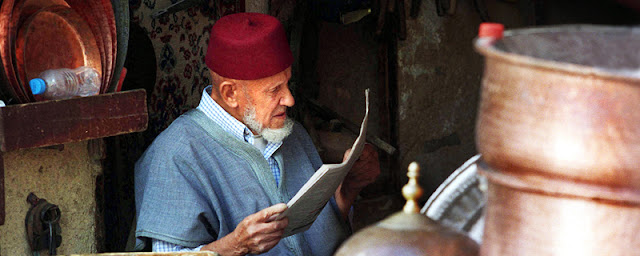Aït Benhaddou is a village in need of rescue. Back in November 2014, heavy storms caused major damage and now, more than a year later, some of the buildings are slowly being restored but the site requires a massive commitment to save its World Heritage values for the future
 |
| Aït Benhaddou before the storm damage |
Situated on the Ounila River in Souss-Massa-Drâa, Aït Benhaddou (Amazigh: Ath Benhadu, Arabic: آيت بن حدّو) is a fortified city, or ksar. It stands on the former caravan route between the Sahara and Marrakech.
For years Aït Benhaddou has been a major tourist attraction as well as a location for a large number of films such as Sodom And Gomorrah (1963), Oedipus Rex (1967), Jesus of Nazareth (1977), The Jewel of the Nile (1985), The Last Temptation of Christ (1988), The Sheltering Sky (1990), Gladiator (2000), Kingdom of Heaven (2005), Babel (2006), Prince of Persia (2010) and Son of God (2014.)
In the fictional world of Essos in Game of Thrones, Aït Benhaddou is turned into Yunkai, the smallest of the three cities in Slaver’s Bay, and Pentos, the biggest of the Free Cities.
 |
| Welcome to Yunkai in Game of Thrones |
Anne Allmeling*, writing for Morocco World News, reports that the repair work is tedious and worthwhile only for a few inhabitants.
Fighting for a Bit of Cultural Heritage
A pile of debris – coarse mud bricks, shattered timber planks, cracked bamboo – has piled up in front of one of the buildings in the mountain village of Aït Benhaddou in southern Morocco. The collapsed façade provides an open view of the inside of the house, which once must have been very grand as the many storeys and the nooks of the tower chamber – or what’s left of them – reveal.
Andreas Reinhartz drops by here on a regular basis, but he cannot get used to the sight of the house. The German-Austrian lives in Aït Benhaddou, is married to a local woman and knows every corner of the mud-brick fortress, or ksar, which consists of many centuries old buildings. In earlier times, caravans passed by here on their way from Timbuktu to Marrakech. Today, the town is off the main road that goes from Casablanca to M’Hamid and is one of the most popular destinations for travellers to Morocco due to its medieval flair. The caved-in house was long in need of repairs, Reinhartz tells me. It took only two consecutive storms in November to turn the old building into a ruin.
 |
| World Heritage - turned to rubble |
Usually, the clay walls can stand up to it,” explains Reinhartz, who has long studied the traditional adobe construction methods in the region. He runs a hostel that was also built in the traditional manner in the new village on the other side of the river. During the storms, he and his wife used any rain-free hours to dry the drenched parts of their house as people have done here for centuries. Reinhartz makes sure to replaster the house regularly to keep the rain from soaking through the walls.
This was the fate of the collapsed buildings. It’s no wonder, for only a few of the houses in Aït Benhaddou are inhabited. Life in the old village, which is protected as a UNESCO World Heritage Cultural Site, is tedious in part because there is no electricity. In addition, maintaining the old adobe fortress requires a great deal of manual work. Clay, wood and rushes are required as construction materials – along with a great deal of physical strength.
Yet rebuilding is often not worthwhile for the locals, sometimes because the old houses are owned by large families that are slow to agree on decisions. All of the old established families have moved across the river to the new village where there are many hotels and restaurants.
 |
| Repair work is tedious |
Tourism is the primary source of income for the inhabitants of Aït Benhaddou. Many of them rent out single rooms or buildings in the kasbah to merchants from all over Morocco who sell souvenirs and jewellery there. Some of them offer their former living quarters in the old village as museums. Recently, two hotels also opened in the old adobe fortress. Their owners make sure that the storm damages to their buildings are mended as quickly as possible. Yet for most of the residents of Aït Benhaddou restoring the old structures is not worthwhile. They cannot earn money with it and have far different worries since the storms: the heavy rainfall not only damaged the kasbah, but agriculture as well.
“We lost one third of our farmland,” says Andreas Reinhartz. “It simply washed away.” His concerns are shared by most families in Aït Benhaddou. The flooding destroyed the harvest and uprooted and swept away the olive trees. It was a major loss for the entire region. Nonetheless, Andreas Reinhartz worries most about the kasbah. It draws throngs of tourists around midday weaving their way for an hour through the ksar on their way from Marrakech to Merzouga. What’s lacking, according to Reinhartz, is long-term, lasting commitment to the kasbah.
*Morocco World News is participating in an interesting journalistic exchange project “Close-Up” with the Goethe-Institut, in which journalists from Germany and Arab countries swap their workplaces for two to four weeks. The editorial journalist Anne Allmeling from Deutsche Welle in Germany is a Morocco World News guest journalist for three weeks. In return, editor Tarik Elbarakah will be the guest of Deutsche Welle in February 2015. You can find more information at www.goethe.de/close-up
SHARE THIS!






